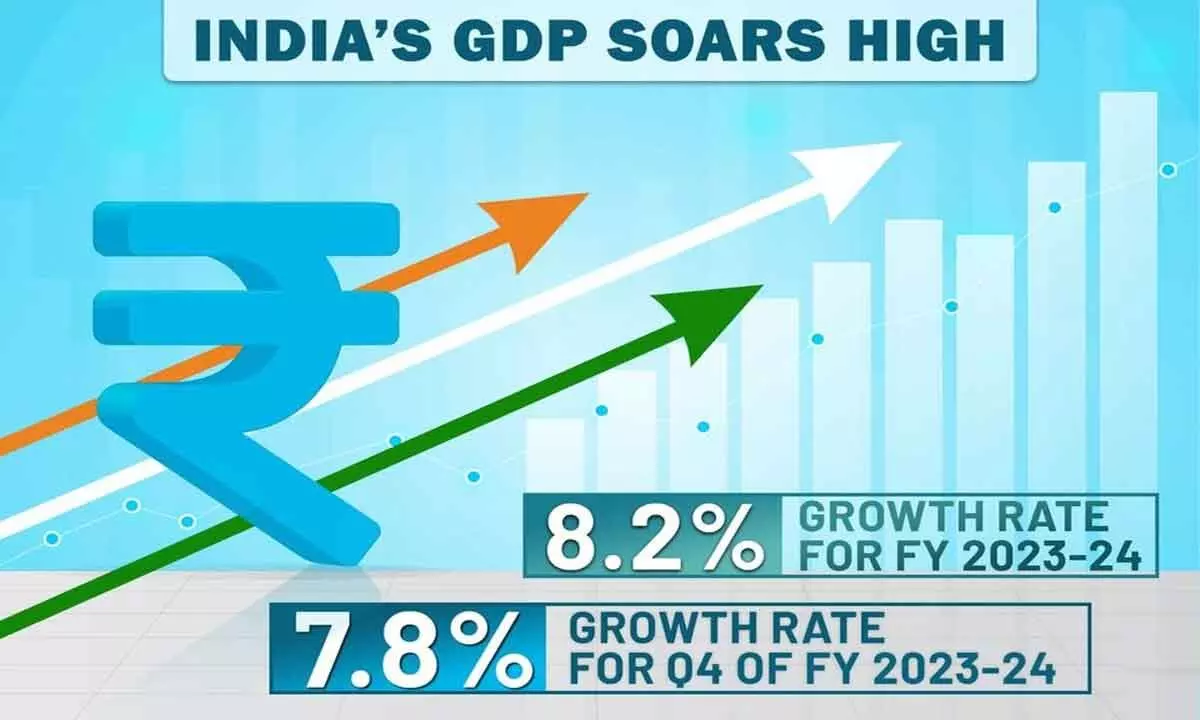Growth with equity is only sustainable model that India should pursue
The country’s current level of per capita income of $2500 has to grow to $22,000
image for illustrative purpose

It has to also continue with adaptation and mitigation plans to become net zero emissions by 2070. This will necessitate combined efforts of the government and private sector and huge investment towards alternative energy projects
One of the prerequisites for growth with equity is to make every citizen financially and economically empowered and provide more opportunities and scope for everyone to involve, actively participate and strongly engage in growth activities along with the growth of the economy.
India, due to the initiatives of both the government and the private sector and the appropriate steps that are being taken, has been performing much better than other countries. This is also being enabled with India's quest to become ViksitBharath by 2047.
This vision should not only be the goal but have the commitment of everyone as it brings immense potential and possibilities for individual growth along with the country's economic growth. The next 25 years being India's Amrit Kaal, needs new thinking, new action, new drivers, new vistas and all-round development given that a developed economy needs large investments, huge savings, substantial infrastructure, both physical and social, new capacities, higher public private partnership, skilled India, digital India and high value exports to all destinations, among several other such crucial factors.
The country’s current level of per capita income of $2500 has to grow to $22,000, which is a huge growth and requires a sustained path to development.
According to an article in RBI Bulletin (July 17, 2023) by H. Behera, V.Dhanya, KunalPriyadarshini and SapnaGoel, the sustainable path to development requires investment in physical capital and comprehensive reforms across sectors covering education, infrastructure, health care and technology to raise productivity. They added that collaboration between the government, private sector, civil society and citizens is essential for driving transformation.
It is understood and expected that government has already on this vision and the new government which proposed a 125-day plan to bring some structural changes and incremental improvements towards laying a strong foundation for short, medium and long term growth on sustainable basis and accomplish the developed economy status by 2047. India has macroeconomic fundamentals that are strong at the moment and it is the right time to aim at implementing the developmental road map.
It has to also continue with adaptation and mitigation plans to become net zero emissions by 2070. This will necessitate combined efforts of the government and private sector and huge investment towards alternative energy projects as the all the factors of climate change, including current huge heat waves, are already happening. India is vulnerable to such physical and transition risks, and, hence, the urgency to mitigate and reduce green emissions.
There should be SWOT analysis at all levels and steps need to be taken to reduce weakness or reduce the impact of threats as strengthening institutional capacity is required to drive towards Vikasit Bharat. The best quality of financial system should be further strengthened with huge capital buffer to take up greater role in nation building. The knowledge-oriented demographic dividend should be utilised for both domestic and overseas purposes. Women's Empowerment and higher involvement in all types of economic activities should result in greater contribution to GDP. Digital India should be role model for India and global good. MSMEs should be strengthened towards global exports. All the sectors, particularly agriculture, should get higher priority to become a global supplier of food products and agro-related exports.
Special efforts have to be taken to ensure that the fruits of the stupendous growth in GDP is transmitted to the bottom of the pyramid with more economic empowerment and financial inclusion as the current income inequalities are to be reduced substantially as growth with equity is the only sustainable model while the inclusive and empowered India can become a role model worthy of emulation.
The current developmental schemes and welfare schemes should be studied from the impact study and the schemes with greater economic and social impact should be further strengthened and some schemes could be discontinued or strengthened with better impact features. While the weakest of weak may need cash subsidies, others should be empowered to do economic activities and should be beneficiaries of such economic activities. Such openings should be enabled by both the Centre and states apart from corporates andinstitutions providing the ecosystem with initial seed financing, better monitoring and handholding as that will ensure growth with equity.
The Vikasit Bharat is a win-win situation for every proud citizen and that can be possible with the active involvement of every citizen. These will be the new horizons of development for the current and future generations as part of the country’s "VasudevKutumbh" mission.
With the success achieved in PM Jan Dhan Yojana with access to financial inclusion, access to credit, access to insurance, access to pension and greater access to Rupay Cards and with mobile connectivity and Aadhar, are the best source for banks to further betterment of their economic inclusion and uplifts them on a sustainable basis.
(The author is former Chairman & Managing Director of Indian Overseas Bank)

